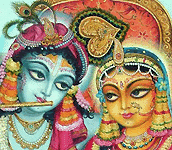seeing through the eyes of scriptures
bibhrad vasah kanaka-kapisam vaijayantim ca malam
randhran venor adhara-sudhayapurayan gopa-vrindair
vrndaranyam sva-pada ramanam pravisad gita-kirtih
Views: 389
-
Comment by Paramananda das on November 16, 2011 at 9:16am
-
The flower ornaments of the divine couple are 1. flower crown, 2. flowers in the hair, 3. flower earrings, 4. flowers decorating the forehead, 5. flower necklaces, 6. flower armlets, 7. flower sashes, 8. flower braelets, 9. flower anklets, 10. flower bodices and many other kinds of flower ornaments. Just as these ornaments may be fashioned from precious jewels, gold or other materials, in the same way they may be made of flowers.
Angada (armlet): A flower-armlet (angada) may be fashioned of three kinds of flowers strung one after another to resemble a little flower creeper.
Balapasya: A garland of flower buds and similar ingredients closely strung together and placed on the hair is called balapasya.
Candratapa (an awning): When many sindhuvara flowers as white as pearls decorate the sides and fresh lotus flowers hang down in the middle, the awning is called candratapa.
Chatra (parasol): Made of thin white sticks, decorated with white flowers and with a handle decorated with yellow jasmine flowers, a flower parasol is called a chatra.

Crown: The divine couple's crowns may be made of rangini flowers, yellow jasmine flowers, navamali flowers, sumali flowers, dhrti gems, rubies, gomeda gems, pearls or splendid moonstones. These may be artistically arranged to construct beautiful crowns. The crowns may be made with seven points and they may also have gold ketaki flowers or various flower buds among their colorful and beautiful ingredients. These crowns enchant the mind of Lord Hari. The flower crowns known as puspapara are the best of all and they are more pleasing than even the best jeweled crowns (ratnapara). Lalita-devi learned how to make these puspapara crowns from Srimati Radharani. These puspapara crowns are made with flowers and flower buds of five different colors arranged in five points.s This crown is especially used to decorate Srimati Radharani.
Decoration for the Forehead: A garland of flowers placed on the upper forehead along the hairline is called lalatika. Such a garland should have flowers of two colors : red in the middle of the garland and the other color flowers on the two sides.
Earrings: Skilled craftsmen say there are five kinds of earrings. They are known by the names tadanka, kundala, puspi, karnika and karna-vestana.
Graivekyaka (flower collar): Made of a single kind of flower, a necklace strung four times around the neck is called graiveyaka.
Hamsaka (flower shoes): When the decoration of flowers covers the entire top and side parts of the feet and there are bunches of flowers in four places, such a decoration is called hamsaka.
Kanci (sash): A sash made of flowers of five different colors, artistically strung together in a gently waving pattern, is called a kanci.
Kanculi (flower bodice): A bodice made of flowers of six colors, artistically arranged and perfumed with musk and which begins from the neck, is called kanculi.
Karnika: The karnika earring is fashioned from the whorl of a blue lotus surrounded by yellow flowers. In the middle are a bhrngika flower and pomegranate flower. When the flower earring is so large it completely covers the ear, the earring is known as karna-vetsana.
Kataka (flower anklets): Anklets made of many different flower buds are called kataka. These are of many different varieties.
Kundala: When an earring is fashioned from flowers in order to resemble a certain object, the earring is called kundala. There are many different kinds of kundala earrings. The flowers may be arrang
-
Comment by Paramananda das on November 16, 2011 at 9:17am
-
this is explained by Srila Rupa Goswami
-
Comment by Paramananda das on November 16, 2011 at 9:17am
-
It is described Krsna wears a crown in Dvaraka so I am going to look for that description as well:
-
Comment by Paramananda das on November 16, 2011 at 9:18am
-
"Although the Lord is by nature very beautiful due to the perfect figure of His transcendental body, still He would dress Himself in yellow colored garments and put on His necklace of Kaustubha jewels. He would wear flower garlands, smear His body with the pulp of sandalwood and decorate Himself with other similar cosmetics and ornaments. It is said that the ornaments themselves became beautiful upon being placed on the transcendental body of the Lord. After decorating Himself in this way, the Lord would then look at marble statues of the cow and calf and visit temples of God or demigods like Lord Siva. There were many brahmanas who would come daily to see the Supreme Lord before taking their breakfast; they were anxious to see Him, and He welcomed them."
Krsna Book, Chapter 70
 Bhaktivedanta Book Trust. HDG A.C. Bhaktivedanta Swami Srila Prabhupada.
Bhaktivedanta Book Trust. HDG A.C. Bhaktivedanta Swami Srila Prabhupada.
-
Comment by Paramananda das on November 16, 2011 at 9:18am
-
this does not mention His crown
-
Comment by Paramananda das on November 16, 2011 at 9:19am
-

Comment
© 2025 Created by Paramananda das.
Powered by
![]()
You need to be a member of Sastra Caksusa to add comments!
Join Sastra Caksusa